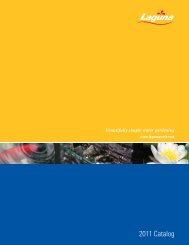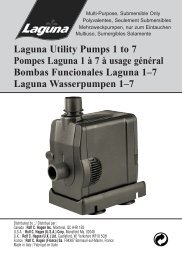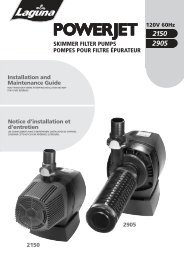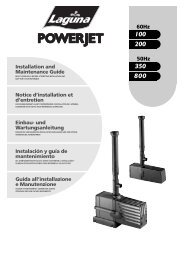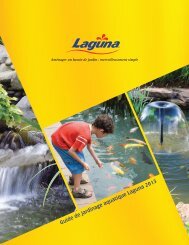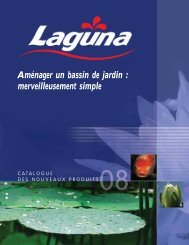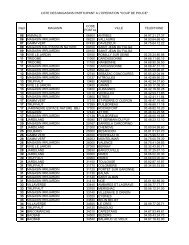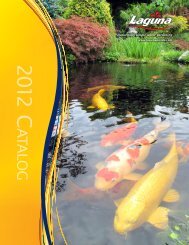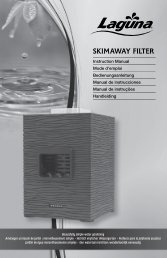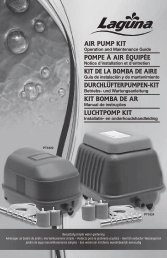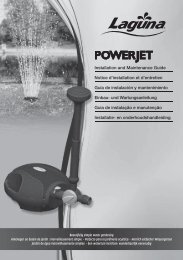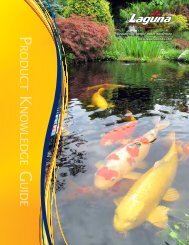Laguna - 2013 Guide to Water Gardening - Lagunaponds.com
Laguna - 2013 Guide to Water Gardening - Lagunaponds.com
Laguna - 2013 Guide to Water Gardening - Lagunaponds.com
You also want an ePaper? Increase the reach of your titles
YUMPU automatically turns print PDFs into web optimized ePapers that Google loves.
Fall &<br />
Winter<br />
Preparing<br />
your Pond<br />
Fish<br />
As the temperature of the water drops, your fish will require less food.<br />
Watch their food intake and adjust your feeding. S<strong>to</strong>p feeding your fish<br />
<strong>com</strong>pletely when the water temperature of your pond reaches an<br />
average of 45°F (7°C). At 47-50°F (8-10°C) the fish will begin <strong>to</strong><br />
hibernate at the bot<strong>to</strong>m of the pond. Regardless of the outside<br />
temperature or if your fish <strong>com</strong>e <strong>to</strong> the surface during the winter do<br />
not feed them. They might be surfacing for oxygen not food. If you<br />
feed them during this period, the food will not be digested.<br />
In most regions your fish are capable of wintering-over right in the<br />
pond. However, if your pond is not large enough, deep enough or is<br />
overpopulated with fish you may have <strong>to</strong> consider moving them indoors<br />
for the winter months; this will require setting up an indoor pond or an<br />
aquarium. You will have <strong>to</strong> pay close attention <strong>to</strong> the care given <strong>to</strong><br />
the fish while they are inside during the winter months. For more<br />
information on setting up and caring for your fish indoors during<br />
the winter visit www.lagunaponds.<strong>com</strong>.<br />
Plants<br />
Tropical plants will not survive the winter if left in the pond (in zones<br />
1 <strong>to</strong> 6a, for plant hardiness zones visit http://planthardiness.ars.<br />
usda.gov/PHZMWeb/Default.aspx). As soon as the water temperature<br />
drops below 15°C (60°F), they should be removed. Some types<br />
can thrive indoors during the winter. Hardy plants should be cut down<br />
<strong>to</strong> about an inch above the root stem and sunk <strong>to</strong> the bot<strong>to</strong>m most level.<br />
However don’t let them cramp the entire floor bot<strong>to</strong>m as the fish will<br />
need room <strong>to</strong>o. While cutting back the plants, remove the build up of<br />
debris and string algae which may have accumulated on the pots and<br />
stems.<br />
Maintenance<br />
The fall brings about a change in weather that signals the need for winter<br />
preparation in colder climate zones. Skim your pond at least once a week,<br />
removing any leaves or plant matter. Ponds should be covered with netting in<br />
order <strong>to</strong> catch the leaves and make them easier <strong>to</strong> remove. Leaves or plant<br />
matter left in the pond will deteriorate over the winter producing organic waste.<br />
It is also important <strong>to</strong> continue dosing your pond water regularly with<br />
beneficial bacteria <strong>to</strong> ensure that there is sufficient bacteria <strong>to</strong> handle the<br />
increase in organic pollution due <strong>to</strong> de<strong>com</strong>posing leaves. Small, partial water<br />
changes are a good idea <strong>to</strong> help dilute any problem that may exist. It is always<br />
a good idea <strong>to</strong> add a full dose of <strong>Water</strong> Prep when performing water changes<br />
or adding water. It eliminates harmful chlorine or chloramines from newly<br />
added tap or well water, immediately making pond water safe.<br />
Depending on the climate zone you live in, late fall is when you will start <strong>to</strong> see<br />
the water temperature of your pond drop below 6˚C (43˚F). When the water<br />
reaches this temperature, submersible pumps should be removed, cleaned and<br />
s<strong>to</strong>red for the winter. Completely take apart and clean your pump, especially<br />
the impeller. S<strong>to</strong>ring your equipment without cleaning it could result in damaged<br />
equipment or a broken impeller shaft when you restart in the spring.<br />
If you are using a secondary smaller water pump ensure that it has been<br />
thoroughly cleaned before use. Your pump should be installed close <strong>to</strong> the<br />
surface of your pond or on bricks <strong>to</strong> prevent cooling of the lower water levels.<br />
This should be done even in climates where the pond freezing over is not an<br />
issue. It is important not <strong>to</strong> leave the pump in the deep area of the pond where<br />
fish will be hibernating for the winter. You will also need <strong>to</strong> disconnect, clean<br />
and s<strong>to</strong>re pond equipment such as UV sterilizers and external filters. If you<br />
have a waterfall you will have <strong>to</strong> disconnect it for the winter months.<br />
In colder climate zones a de-icer and/or aeration kit should be added <strong>to</strong> keep<br />
a hole open <strong>to</strong> allow water circulation and oxygenation throughout the winter<br />
and allow for proper oxygen/carbon dioxide gas exchange for fish <strong>to</strong> survive<br />
the winter.<br />
A patch of leaves left in the<br />
deepest part of the pond can<br />
help <strong>to</strong> provide shelter when fish<br />
are being kept in the pond for<br />
the winter.<br />
46 ••• maintenance & Winterizing



